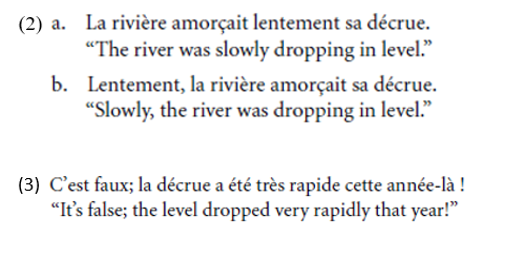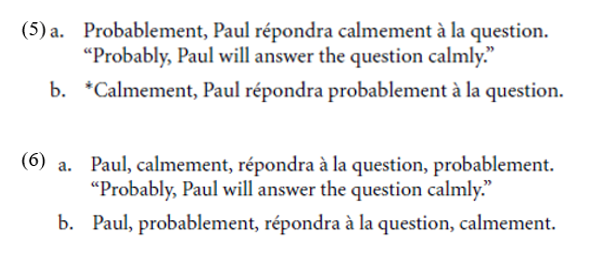


 Grammar
Grammar
 Tenses
Tenses
 Present
Present
 Past
Past
 Future
Future
 Parts Of Speech
Parts Of Speech
 Nouns
Nouns
 Verbs
Verbs
 Adverbs
Adverbs
 Adjectives
Adjectives
 Pronouns
Pronouns
 Pre Position
Pre Position
 Preposition by function
Preposition by function 
 Preposition by construction
Preposition by construction
 Conjunctions
Conjunctions
 Interjections
Interjections
 Grammar Rules
Grammar Rules
 Linguistics
Linguistics
 Semantics
Semantics
 Pragmatics
Pragmatics
 Reading Comprehension
Reading Comprehension
 Teaching Methods
Teaching Methods|
Read More
Date: 2025-04-19
Date: 2024-01-23
Date: 2024-01-16
|
Prosody, scope, and pragmatic status
The grammar fragment accounts for the semantics and pragmatics of evaluative adverbs occurring sentence-initially in assertions. What remains to be seen is how this fragment can be extended to the general case. In this section we deal with the issue of non-sentence-initial occurrences of evaluatives. In the next section we discuss the specific problems raised by evaluatives in questions.
At this point, we should stress an important distinction which is not usually made in the literature (Bonami et al. 2004): the distinction between a prosodic property, called here incidentality, and a semantico-pragmatic property, called here parentheticality. Expressions are incidentals when they are not prosodically integrated in the sentence: they are set apart by a number of prosodic cues that make them akin to independent intonational phrases (Fagyal 2002). This corresponds to what is referred to as “comma intonation” in much of the literature. On the other hand, parentheticals are expressions that do not contribute to the main semantic content, but provide an ancillary commitment. This may correspond to the terms “disjunct” (Greenbaum 1969; Espinal 1991) or “supplement” (Huddleston and Pullum 2002; Potts 2005). The problem is that these two properties are usually conflated. However, this is a mistake: the two properties are independent.
Consider (1), where incidentality is noted by commas, and prosodic integration by an absence of commas. It is clear that an evaluative adverb, which is a parenthetical, can be either incidental (1a) or integrated (1b).

As exemplified in (2), manner adverbs can also be used either with an incidental or an integrated prosody. Note that (3) is an appropriate response to both (2a) and (43b), which shows that manner adverbs contribute to the main content, irrespective of their prosody.

We conclude that the prosodic property of incidentality and the pragmatic property of parentheticality are independent. Actually this is to be expected, since the two properties have independent sources: being a commentary is a property of lexical items while being incidental is a property of their occurrences. Accordingly, evaluatives are parentheticals while manner adverbs are not, whether or not they are incidentals.
A final quick clarification is in order concerning the interaction of incidentality with interpretation. That incidentality is orthogonal to being a parenthetical does not mean that the prosodic property has no import on interpretation. In fact, it is crucially correlated with scope (Bonami et al. 2004): the correlation between scope and the syntactic property of order (alternatively, c-command in some other approaches)1 that characterizes integrated adverbs does not hold for incidentals. The findings are summarized in (4).

Let us take two adverbs whose relative scope is clear and well known: for obvious semantic reasons, modals have scope over manner adverbs, but not the other way around. Compare examples in (5), with one incidental and one integrated adverb, and (6), with two incidentals. Sentence (5b) is not acceptable, because the manner adverb is incidental and thus must have scope over the integrated modal adverb, which is not a licit scoping. Sentence (6a) shows that the incidental manner adverb may very well occur to the left of the modal adverb, as in (5b). In fact, in (6), the two orderings are acceptable, because both adverbs are incidental, and the relative scope of incidental adverbs is not constrained by order. Although we cannot dwell on this matter here, the import of incidentality on adverb scoping indicates that the prosodic behavior may be related to syntactic properties (mode of combination).

These observations mean that a satisfying fragment accounting for the scope of evaluative adverbs cannot be formulated before hard decisions about the syntax of incidentality, and the syntax–semantics interface for modifiers in general, have been made. Bonami and Godard (2007a) proposes a general syntactic treatment of incidental adverbs, relying on a distinction between phrase structure and word order domains (Reape 1994; Kathol 2000): according to this analysis, incidental adverbs are always adjoined to clauses in phrase structure, but can be linearized in different positions via domain union. Bonami and Godard (2007b) provides a syntax–semantics interface for evaluative adverbs which deals in detail with the scopal properties of integrated occurrences, by adopting Bouma et al.’s (2001) syntax for VP-internal modifiers andcoupling it with underspecified semantic representations based on Minimal Recursion Semantics (Copestake et al. 2006). Integrating this syntactic and combinatory semantic work with the present work on the lexical semantics and pragmatics of evaluative adverbs would yield a complete analysis of evaluatives in assertive contexts.
1 In a framework where adverbs are systematically the left daughter in a right-branching structure, the correlation can be reduced to a relation between scope and c-command rather than scope and order.
|
|
|
|
حقن الذهب في العين.. تقنية جديدة للحفاظ على البصر ؟!
|
|
|
|
|
|
|
علي بابا تطلق نماذج "Qwen" الجديدة في أحدث اختراق صيني لمجال الذكاء الاصطناعي مفتوح المصدر
|
|
|
|
|
|
|
ضمن برنامج تأهيل المنتسبين الجدد قسم الشؤون الدينية يقدم محاضرات فقهية وعقائدية لنحو 130 منتسبًا
|
|
|